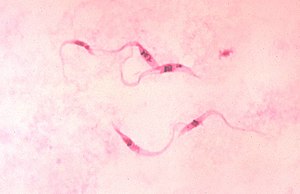Trypanosomiasis
| Trypanosomiasis | |
|---|---|
 |
|
| Classification and external resources | |
| Specialty | infectious disease |
| ICD-10 | B56-B57 |
| ICD-9-CM | 086.5-086 |
| MeSH | D014352 |
Trypanosomiasis or trypanosomosis is the name of several diseases in vertebrates caused by parasitic protozoan trypanosomes of the genus Trypanosoma.
In humans this includes African trypanosomiasis and Chagas disease. A number of other diseases occur in other animals.
Approximately 30,000 people in 36 countries of sub-Saharan Africa have African trypanosomiasis, which is caused by either Trypanosoma brucei gambiense or Trypanosoma brucei rhodesiense. Chagas disease causes 21,000 deaths per year mainly in Latin America.
The tsetse fly bite erupts into a red chancre sore and within a few weeks, the person can experience fever, swollen lymph glands, blood in urine, aching muscles and joints, headaches and irritability. In the first phase, the patient has only intermittent bouts of fever with lymphadenopathy together with other non-specific signs and symptoms. The second stage of the disease is marked by involvement of the central nervous system with extensive neurological effects like changes in personality, alteration of the biological clock (the circadian rhythm), confusion, slurred speech, seizures and difficulty in walking and talking. These problems can develop over many years and if not treated, the person dies. It is common to the African continent.
Diagnosis is often missed in the first phase of the disease due to non-specific nature of symptoms. Pentamidine and Suramin are used for treatment in the first phase. Melarsoprol, nifurtimox and eflornithine are drugs used in second phase of the disease. However none of the therapies available are optimal in terms of adverse events and ease of administration.
Some species of cattle such as the African buffalo, N'dama, and Keteku appear trypanotolerant and do not develop symptoms. Calves are more resistant than adults.
...
Wikipedia
